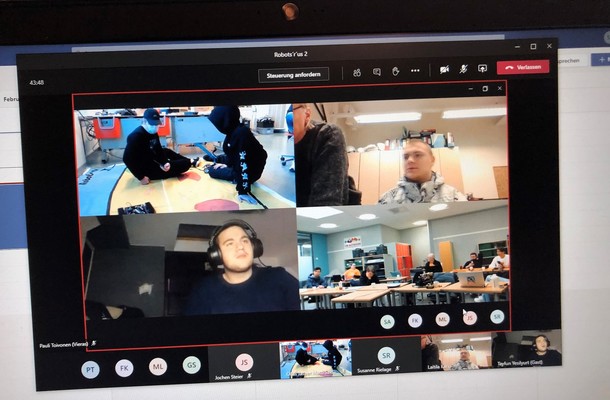Report on the last day of the presentation days in February 2021 – Wednesday 3rd February 2021
This day was dedicated to the presentations of the robots that had been built within the framework of this project.
The Spanish group started right at the beginning and before they showed their robot, they presented the results of their survey that they had done in order to find out to what extent the ICT skills in the students had improved during the project. (This survey and the results of the German team can be seen on etwinning ‘ICT survey’). The Finnish and the Norwegian team did not do a standardized survey but presented the improvements in their students’ ICT skills through quotes from their students and a collection of observations during work processes because these partners did not have a fixed and continuous group of students that took part from the beginning.
After that the Spanish team presented the technology used in their robots (they had two functioning robots) for the required tasks. One robot worked with a bracket that lifted up the obstacles on the playground (as pieces of rubbish on a beach), the other one worked with a gripper that gripped the object.
The students also presented their setbacks and challenges that the two technologies brought about and explained how they solved them in the team. Through these presentations not only their technical skills but also their team abilities became obvious.
As the list of criteria that would be applied to the presentation not only consisted of features that the robot would have to have but the students themselves (like communication abilities, presentation skills and team work capabilities, see ‘List of criteria’) this presentation very convincingly showed that the students had also prepared themselves well in this respect.
The robot with the gripper worked with a Bluetooth control, the one with the bracket with sensors. Both robots were an impressive solution to the given tasks, although the gripper robot decided spontaneously not to show what it was able to do. The bracket robot, however, reliably went to the pieces of trash, avoided the obstacles (stones printed 3-D at the school), picked up the can and carried it back to the starting point.
The presentation of the Spanish team was carried out as a live stream and was watched by other classes in the IES Puerto del Rosario and more spectators in Fuerteventura, in the end more than 300 people had followed the presentation online on the school’s facebook site.
The second group that impressively showed that their robot also worked correctly was the Norwegian group in Svolväer, Lofoten. Their robot drove on tracks and had a big brush with which it picked up the ‘trash’ and carried it back to the starting point. It worked with sensors and also found its way independently, just like the Spanish bracket one. An additional feature was the VR glasses that could be worn by a supervisor who could thereby watch the robot’s performance from a distant place.
The Finnish team presented three robots, two that drove on tracks, one of them with a long arm to pick up the trash, one with a shovel that would also be useful in a snowy winter. A 3-D camera on top of it helped to keep orientation for the vehicle. The third robot was a finished product and looked like a spider. These three models showed that the Finnish students had dealt with different robot solutions and learnt a lot about automated technology, and therefore also got a reasonable number of points, even if their robots didn’t carried out the tasks. One has to say, that the team was very new and had only worked together since October 2020.
Last not least, the German team showed their robot with a wooden chassis and a brush to pick up the ‘trash’ on the playground. Unfortunately, the team had been in lockdown for 6 weeks and could not meet at school. Therefore they passed the robot from student to students and completed it that way. They also showed a functioning robot that went to the objects that he then picked up and brought them back to the starting point. This he did by being remotely controlled by one student. And its construction with the brush had also worked perfectly.

After each “robot show” the students of each responsible team answered lots of questions about their machine and explained their specific technical solutions and where sustainability came in through choosing recycled or recyclable components like batteries or pre-used materials.
After the presentations the students proudly received a lot of acknowledgement from the project coordinator Susanne Auer, their headmasters, their educational departments and the European Office in their regional governments.
Some students took the opportunity to thank the participating teachers for the great time they had during their problem solving activities with their international partners online and during their trips to the partnerschools, where they not only experienced a new culture but also new and exciting geographical conditions and free time activities. They went climbing mountains in Norway, explored beaches in Fuerteventura, built snowmen in snowy forests in Finland and experienced “summer in the city”-life in Dortmund, Germany.
With these praising words from the students the final presentation conference of this Erasmus+ project “Robots ‘R Us” was finished and the conference was closed.
The German team who was the only team who could not share their success with others but had to be at home on their own when following the conference, will hopefully have the opportunity to celebrate their success another time at school when the German team is allowed to get together again for a final little festival.
See all robots https://www.facebook.com/Robotsareuserasmusplus
https://youtu.be/OJeFV6Kxh2c